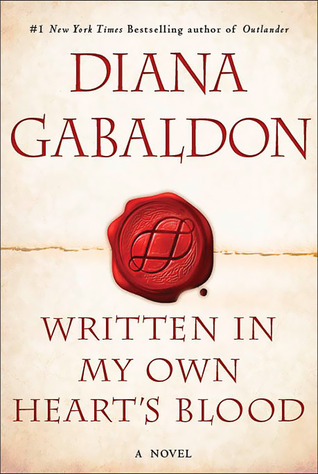Written in My Own Heart's Blood

Summary (from the publisher): Written in My Own Heart's Blood is the eighth novel in the world-famous Outlander series. In June of 1778, the world turns upside-down. The British army withdraws from Philadelphia, George Washington prepares to move from Valley Forge in pursuit, and Jamie Fraser comes back from the dead to discover that his best friend has married Jamie’s wife. The ninth Earl of Ellesmere discovers to his horror that he is in fact the illegitimate son of the newly-resurrected Jamie Fraser (a rebel _and_ a Scottish criminal!) and Jamie’s nephew Ian Murray discovers that his new-found cousin has an eye for Ian’s Quaker betrothed.
Meanwhile, Claire Fraser deals with an asthmatic duke, Benedict Arnold, and the fear that one of her husbands may have murdered the other. And in the 20th century, Jamie and Claire’s daughter Brianna is thinking that things are probably easier in the 18th century: her son has been kidnapped, her husband has disappeared into the past, and she’s facing a vicious criminal with nothing but a stapler in her hand. Fortunately, her daughter has a miniature cricket bat and her mother’s pragmatism.
The best of historical fiction with a Moebius twist, Written in My Own Heart's Blood weaves the fibers of a family’s life through the tapestry of historical drama.
Meanwhile, Claire Fraser deals with an asthmatic duke, Benedict Arnold, and the fear that one of her husbands may have murdered the other. And in the 20th century, Jamie and Claire’s daughter Brianna is thinking that things are probably easier in the 18th century: her son has been kidnapped, her husband has disappeared into the past, and she’s facing a vicious criminal with nothing but a stapler in her hand. Fortunately, her daughter has a miniature cricket bat and her mother’s pragmatism.
The best of historical fiction with a Moebius twist, Written in My Own Heart's Blood weaves the fibers of a family’s life through the tapestry of historical drama.
Review: This book is the eighth installment in the epic Outlander series. This novel picks up the story where it was left at the conclusion of book seven: it is 1778 and the characters are swept up in the Revolutionary War, Jamie (supposed dead at sea) has reappeared to claim his wife, Claire continues to treat patients, Jamie's illegitimate son discovers his true parentage, and Ian has found love again. Meanwhile, in 1980, Jamie and Claire's daughter Brianna and her husband Roger are facing trials of their own and Roger has travelled back in time again to try to find their son.
I read the seventh book in September 2012, so it did take me a bit to pick up where the story had left off, however, I found that Gabaldon leaves the reader enough hints that I was able to get back into the groove of the narrative without confusion. However, this is not to say that you should read these books out of order. The plot of these books is complicated and somewhat convoluted - you would miss much and likely enjoy this series little if read out of order.
As you can tell from my brief summary, the plot of this book is all over the place. "'No, her husband is my brother's adopted son,' Jenny explained. 'But I raised Fergus from a wee lad myself, so he's my foster son, as well, by the Highland way of reckoning.' Mrs. Figg blinked. She had been gamely trying to keep the cast of characters in some sort of order to this point, but now gave it up with a shake of her head that made the pink ribbons on her cap wave like attennae" (11). The series has multiple disparate plot threads covering dozens of characters - which helps explain why each book is close to one thousand pages. Ordinarily I would list this complexity and convoluted plot as a negative, however, affection for the characters, built over reading about them for thousands of pages, prevents me from feeling this way. Readers of the eighth book can only be devoted fans, who have stuck with the series because they love them, and have read along and kept up with the twisting of the plot.
This novel delves into the idea of how time might be changed by moving in time more than the others books do, principally due to Roger and Brianna travelling back to 1739. Roger and Brianna feel helpless to warn their ancestors they encounter about what they know about their fate for fear that they will alter the future negatively, possibly even writing themselves or their loved ones out of existence. It was also interesting to see actual historical figures continue to appear, including Peggy Shippen, Benedict Arnold, and George Washington.
One (of the very many) things I've always loved about this series is Claire's work treating eighteenth-century patients with twentieth century knowledge. Claire certainly has ample opportunity in this installment, as the Revolutionary War rages about her. On the other hand, it got a bit gruesome even for me, such as the amputation she performs described in great detail: " A deep incision, fast, around and across the top of the leg, cutting hard down to expose the bone" (677).
I always have a hard time reviewing these novels, partly because I don't want to give any plot points away, but also because the plot itself doesn't lend itself to a quick summation. Although I wish Roger and Brianna's story had covered in more detail in this novel, I think the next novel will go back to explain what they've been up to. However on the whole, as a devoted Outlander fan, I was pleased with this novel - it remains vast and far-fetched, but it's characters, historical detail, and innovative use of fictional time travel keep me hooked.
Stars: 4


Comments
Post a Comment